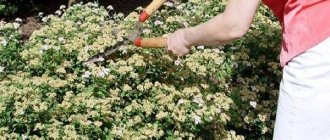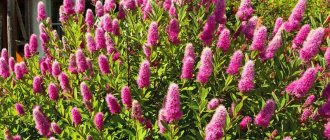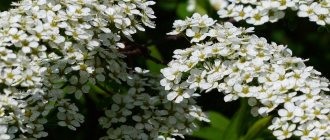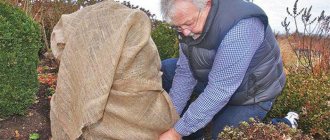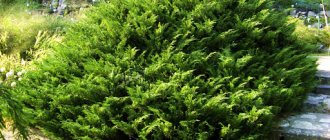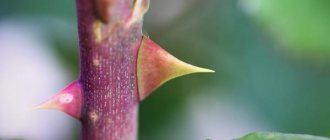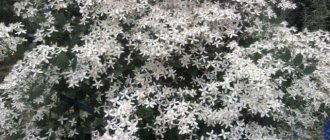Spiraea Vangutta photo, description, planting and care
Before we move on to the description, characteristics and recommendations for caring for this plant, we suggest that you familiarize yourself with the most popular varieties of this species. It has several decorative forms, let’s talk about them in a little more detail:
Spiraea Vangutta: photo and description
The plant belongs to fast-growing ornamental shrubs from the Rosaceae family. The deciduous hybrid was obtained as a result of crossing between two spirea - three-lobed and Cantonese. This variety has been known since 1868. If in the 19th century botanists managed to obtain plants only with white five-petal flowers and dark green leaves, today there are various forms of spirea with pink double flowers and variegated decorative foliage.
Planting spirea: choosing soil
Lush, abundant flowering of this shrub can only be achieved if the plant is exposed to the sun for a sufficiently long time. Otherwise, spirea are unpretentious in care, and they do not require special care or a specific place for planting.
For representatives of this family, loose, drainable soils with the presence (in moderation) of nutrients are most suitable. It is best to prepare a soil for planting consisting of the following components: 2 parts turf soil, 1 part sand and the same amount of low-lying peat. It is recommended to conduct a soil analysis and perform the following activities before planting:
- In heavy loamy soils or black soil, it is necessary to add peat or sand before planting shrubs.
- Soils poor in organic matter, on the contrary, are enriched with fertile soil and mineral supplements.
- If the soil composition is too acidic, it should be deacidified.
For this type of shrub, autumn planting is preferable. Spiraea Wangutta is planted in the ground no later than mid-October. If this was not possible, planting can be done in the spring before the active movement of juices in the plants begins.
When planting a plant in a new place, you need to pay attention to the following nuances:
- optimal place for the root system;
- eliminate lack of nutrition and moisture;
- plants need to take root before frost sets in.
- in a single planting, in this case it is necessary to prepare a planting hole with a depth of 50 cm and the same diameter;
- in groups, the distance between seedlings must be maintained as follows - 0.7-1.5 m;
- as a hedge, the planting holes in this case are located at a distance of one and a half meters both between plants and between adjacent rows.
After planting, caring for spirea Vangutta begins immediately. First of all, the tree trunk circles must be well compacted and shed with warm water in such a way as to thoroughly moisten the entire root system of the plant. To retain moisture for a longer period, mulch the soil around the tree trunks.
Spiraea Vangutta has the following feature: seed germination is only 5% of the total amount. Therefore, plants are most often propagated by layering, dividing the bush or cuttings. Let's consider these methods in more detail.
Rooting by layering
This method of propagating spirea Wangutta is easy to implement during plant transplantation. The bush is dug up and divided into the required number of parts, in each of which strong roots and well-developed shoots should remain. It is best to treat the cuts with crushed coal. Then the roots are planted in pre-prepared holes.
This method is used 2 weeks after flowering. Healthy and strong shoots are chosen as cuttings. A substrate is prepared, consisting of river sand and peat, taken in equal proportions, and the cuttings are planted in it for rooting. It is recommended to place the shoots in a greenhouse or greenhouse; this will ensure a high level of air and substrate humidity. A year later, the cuttings have a well-developed root system and are planted in separate containers for growing.
Landscape design
The most widespread type of these ornamental shrubs is in the creation of hedges. The following characteristics are attractive in the Vangutta spirea:
- decorative qualities;
- abundant flowering;
- spherical crown.
The shrub is used for single and group plantings, as well as in more complex compositions - for borders. It is also used to frame artificial reservoirs located on the site. Vangutta looks very impressive against the backdrop of a green lawn, near the fountains, next to the pool. With the help of these bushes you can decorate unsightly buildings, any outbuildings or old dilapidated houses. You can combine this type of spirea with various trees, for example, pine, spruce, maple or fir.
Spiraea in landscape design: photos and examples of use
Plants of this species are most widely used as spirea hedges, helping not only to hide the area from prying eyes, but also to become its true decoration.
Read also: “Daybera Black” - the most remarkable features of the variety, as well as tips for care and planting
A voluminous bush with drooping shoots will look good against the background of other ornamental crops, such as mock orange or lilac. The Vangutta spirea shrub is good in both group and single plantings. It will not get lost anywhere and will become the center of any composition.
Good neighbors for the Vangutta spirea will be the relatives of the summer flowering period that are taking over the baton.
From the photo of spirea in landscape design one can judge the versatility and high decorativeness of this plant in different seasons of the year. In spring, the shrubs early become covered with beautiful green or variegated foliage, followed by abundant flowering that lasts up to three weeks. And even after him, the Vangutta spirea does not lose its charm. By autumn, its leaves turn a variety of shades of yellow, orange, red and deep purple.
Spiraea Vangutta White Bride - video
Varieties of spirea
Japanese spirea planting and care photo
The genus Spiraea is part of the Rosaceae family and includes over 80 species of ornamental deciduous shrubs. The average height of the crop is 90–170 cm, the crown circumference reaches 2.5 m. The openwork crown is made up of thin shoots that bend under the mass of inflorescences almost to the ground. Therefore, spirea is often compared to a snow-white fountain. The first flowering occurs in the 3-4th year of the growing season and is limited to the appearance of individual inflorescences. In subsequent years, the shrub tirelessly pleases gardeners with its splendor. The plant can act as a spectacular soloist or join a group. Due to their hardiness, unpretentiousness, and resistance to dust, spirea are often used as hedges.
The timing and features of pruning shrubs directly depend on its variety. All types of spirea are usually divided according to flowering time into spring-blooming and summer-blooming. Let's look at the main representatives of these groups.
Early flowering (spring) species of meadowsweet
Snow-white flowers with a yellow core and incredibly long stamens are a characteristic characteristic of early-blooming spirea. Dense corymbose or umbrella-shaped inflorescences densely cling to thin shoots, causing them to bend to the ground. The appearance of “snow” on the branches occurs at the end of spring or beginning of summer. Flower buds are formed on last year's shoots and are located along the entire length of the branches. The May “snow storm” lasts only 2-3 weeks, fills the garden with fragrance, attracting a lot of pollinators.
The following spring types of spirea are most often found in cultivation:
- Wangutta;
- Nippon;
- Thunberg;
- oakleaf;
- Gray;
- Arguta;
- Average;
- Gorodchataya.
They differ slightly in height, shape of crown and leaves, size of flowers and inflorescences. Some representatives have a snow-white color, others have a cream color. Nippon spirea dresses up in a crimson dress in autumn, and Vangutta burns with an orange flame.
The listed varieties are light-loving, but tolerate light shading. Spiraea are capable of growing in spartan conditions, but without proper pruning and periodic rejuvenation, they first grow and look sloppy, and then begin to wither and lose their decorative effect.
Summer-blooming spirea
Representatives of this group bloom throughout the summer. They are characterized by bright, rich colors of inflorescences - pink, reddish, purple. Inflorescences are formed on the current year's growths and have the shape of panicles or large corymbs.
Summer-flowering spirea include the following species:
- Birch leaf;
- Billard;
- Felt;
- Willow;
- Dwarf;
- Boumalda;
- Douglas;
- Densely flowered.
Like their spring sisters, summer-blooming spirea are unpretentious, light-loving, and can withstand gas pollution. The listed crops will fit perfectly into the design of any garden and will decorate a garden bed or mixborder. Gardeners are especially attracted to Japanese spirea, from which a lot of beautiful varieties and decorative variegated forms have been obtained. Cultivars of Japanese meadowsweet can be easily shaped and used to create garden sculptures.
The best types - for every taste and color
During breeding, breeders bred a large number of species of Wangutta. Among them there are also ones with pink inflorescences. All plants inherited the best characteristics of the variety.
| Name | Description |
Snow white or white bride | A classic look with large snow-white umbrella-shaped inflorescences, their diameter is 60 cm. The bush is spreading, grows up to 2 meters in height |
Snow White | The medium-sized Canadian species grows up to 150 cm, has a crown with a diameter of up to 180 cm. Large inflorescences are painted snow-white |
Renaissance | The species was bred in the USA, tolerates diseases and is resistant to pests. Ideal for creating hedges |
Pink Ice | Ornamental shrub with pink inflorescences and marbled leaves, a combination of cream shades with olive splashes |
Gold Fontaine | A new species was bred by Polish breeders. This is a slow-growing shrub up to 120 cm high. The crown has a diameter of up to half a meter. The plant is strewn with white flowers, which are collected in corymbose inflorescences |
How to propagate spirea Wangutta
Japanese Kerria photo, description, planting and care
Currently, propagation of the ornamental shrub spirea Vangutta is possible in several ways: seeds, cuttings, dividing the bush and layering. Each of them allows you to increase the beauty of your personal plot, but has its own characteristics and tricks.
Propagation by cuttings
Cuttings from bushes that bloom in spring should be taken in June, and cuttings from spirea that bloom in summer should be taken at the end of July. Harvested cuttings take root by mid-autumn.
For cuttings, select a strong one-year-old shoot and divide it into cuttings with 5-6 buds. The lower leaves are removed from the cuttings, and the rest are cut in half. To increase efficiency, it is recommended to soak the resulting cuttings in a solution of Epin and a root growth stimulating agent. The sections remaining on the spirea bush must be treated with garden varnish.
The resulting cuttings are planted in a moist substrate, which can be vermiculite, sand, fertilized soil or perlite. In some cases, it is desirable to create greenhouse conditions by covering the container with seedlings and maintaining a uniform temperature and constant humidity in it.
It is important to periodically give them plenty of fresh air, and during cold spells to protect them from low temperatures. This can be done with foliage, branches, tops and any available material.
Planting cuttings in open ground is carried out in the spring, when small shoots and root systems appear.
The resulting Vangutta spirea shrubs should be planted in pre-prepared planting holes in which the soil is fertilized and drainage is provided.
In autumn, propagation by layering gives results - an additional root system is formed at the site of the cut, and a new seedling can be separated and planted.
Did you know?
From long shoots you can get several new cuttings at once by burying the selected branch in several places.
Types and timing of shrub pruning
Marigold plant Photos, types, cultivation, planting and care in open ground
Throughout the growing season, meadowsweet must be periodically pruned. This plant is so plastic that it can be easily shaped, and reacts very positively to pruning, throwing out more powerful shoots and forming a larger number of inflorescences. Thanks to shearing, it is possible to achieve an increase in the decorative value of the crop, because meadowsweet is a fast-growing species. It produces a lot of root shoots and shoots, so without timely trimming it will become a sloppy bush.
Depending on the goals pursued, spirea pruning is divided into the following types:
- sanitizing;
- stimulating;
- formative;
- rejuvenating.
Meadowsweet shoots are short-lived and after 1-2 years they begin to dry out. If you leave them on the bush, the branches will become a haven for pests and a breeding ground for fungal spores. Some types of shrubs do not tolerate frost very well; the tips of the branches freeze slightly. To protect the crop from diseases and restore its decorative appearance, gardeners remove diseased, dry, broken branches throughout the growing season. Frozen shoots are cut out in the spring before the buds open.
Stimulating haircut is used for early flowering meadowsweet over 3-4 years old. By removing weak shoots, branching is stimulated and flowering is enhanced. This approach will improve illumination and ventilation of the crown, which will have a beneficial effect on the health of the crop. Stimulating haircut is carried out in early autumn.
The formation of shrubs is usually done in spring or autumn. The autumn period is less busy for gardeners, so the spirea crown is most often formed in the fall.
Plants older than 15 years will need anti-aging pruning. From this age, biological aging begins, the bush gradually loses its attractiveness. Autumn pruning is done 2-3 weeks before frost, so that the wounds have time to heal.
Care instructions
For active growth and abundant flowering, spirea must be properly cared for: watered, fertilized, pruned, protected from diseases and pests.
Watering
Regular removal of weeds and loosening of the soil will help improve soil moisture during watering and the absorption of fertilizers during fertilizing.
Advice! By mulching the root zone of the spirea with a layer of 10 cm, there will be no need to loosen and weed the soil.
The plant does not like stagnation of water at the roots, so the frequency of watering is chosen depending on the composition of the soil. Usually the bushes are watered 3-4 times a month, and more often during drought.
You should also spray the crown with warm water. This will improve the growth of the plant.
Fertilizer
If, when planting, the spirea was covered with a nutrient substrate, it does not need to be fertilized for the first year. Next, feed the bushes with complex phosphorus-potassium fertilizer once a season. The tree trunk circle is mulched with organic matter, for example, rotted manure.
Trimming
In order for spirea to bloom beautifully, it is necessary to form a crown and carry out sanitary cleaning. Remove dried, old and diseased branches, leaves and inflorescences.
Advice! In order for the plant to overwinter well, pruning must be done before the onset of cold weather.
During the season, 2-4 prunings are carried out, which spirea tolerates well.
Remember that spirea blooms on the branches of the second year. Therefore, you need to leave 1-2 strong buds on them.
Watch the video! How to trim VANGUTTA sperry
Spiraea Wangutta description
This shrub, despite its beauty and unpretentiousness, is not so well known among gardeners in our country, but those who nevertheless come across the Vangutta spirea irrevocably fall in love with it. That is why you should understand what Spiraea Vangutta is, a description of which is presented below.
The ornamental shrub of this variety was bred in the middle of the 19th century as a hybrid based on two varieties already known at that time. Thanks to its impressive size (up to 2 meters in height and diameter), the shrub involuntarily attracts the eye. In addition, when the spirea Vangutta blooms, it is covered with lush white flowers, distinguishing the bush with its unique beauty among other plants.
Due to the abundance of flowering brushes, as a rule, the shoots of the bush bend towards the soil, forming sweeping arc-cascades. The bush begins to bloom in late spring - early summer and lasts 2-3 weeks. It is not uncommon for spirea Vangutta, after flowering in the spring, to bloom a second time towards the end of summer, but it is worth noting that the second flowering is not so abundant and beautiful. It is noteworthy that spirea can also be planted in apiaries, since bees willingly pollinate the plant and feed on its nectar.
Important! Spiraea Vangutta is one of the plants that prefer an abundance of sunlight, but this shrub easily tolerates prolonged shade, only slightly slowing down in growth rates.
The shoots of the bush are quite long and have a characteristic dark brown color. The white flowers are quite small, but densely cover all branches, giving them noticeable volume. In addition to the classic color, varieties of the variety with a wider range of colors are now being actively developed.
Did you know?
At the end of the 19th century, botanists were able to obtain spirea Vangutta with white five-petaled inflorescences. Today you can already find this shrub with pink and double flowers and foliage of decorative shape and color.
Varieties
Spiraea Vangutta looks different depending on the variety. There are more than a dozen varieties that differ in size, timing and duration of flowering.
Gold Fontaine
Spiraea Gold Fountain appeared due to a mutation of Spiraea Wangutta. It has more pronounced decorative properties. It is a compact spherical shrub up to 1.2 meters high with orange-reddish branches. The bush grows up to 1.5 meters in diameter. Gold Fontaine grows slowly, gaining 15-20 cm per season.
Young leaves turn orange-red in spring and change color to bright yellow in summer.
Advice! In order for the leaves to retain their golden color, the bush must grow in full sun. In the shade the foliage turns green.
There are many flowers. They are small, white, and collected in hemispherical inflorescences. They exude a fragrant, honey aroma. Such bushes are used for hedges, in single plantings and group compositions. Spiraea Gold Fontain is often used for urban landscaping. It is frost-resistant and can grow in any soil.
Pink Ice
Spiraea Pink Ice is a spherical shrub with variegated foliage and red branches. The bush grows up to 1.5-2 meters in height and width. Young leaves are creamy white, sometimes pinkish. As they grow, they become pale green with cream spots.
Pink Ice blooms in May-June with numerous small white flowers, collected in hemispherical inflorescences that completely cover the shoots. Looks beautiful in contrasting compositions, for example, with barberry. Grows well in soil with weak or alkaline acidity, in which water does not stagnate. It is frost resistant. But it can freeze at very low temperatures.
Renaissance
A hybrid of American selection that grows quickly and grows up to 1.5 meters in height and 2.0 meters in width. However, it is more compact than Spiraea Vangutta. There are many branches, they are slightly curved.
Blooms from April 15 to May 30 with creamy white flowers. The leaves are small with finely toothed edges and bluish-green in color.
Grows well in sunny areas. Has high immunity to diseases. It is frost resistant. Does not require constant pruning. Used in single plantings and mixed compositions.
Snow White (snow whait)
Snow White is a bush with a compact rounded crown that resembles a vase. Grows up to 120 cm in height and 150 cm in width. The branches are curved, the leaves are dark green, turning orange-red in the fall. In spring they bloom profusely with white flowers.
The shoots cascade down to the ground. Has good frost resistance. It is used for landscaping parks and squares, forming hedges in single plantings and mixed compositions. Grows well in sunny areas.
How to properly plant spirea Vangutta in the garden
Proper planting of a shrub largely determines not only the growth rate and flowering activity, but also whether the spirea will take root in the chosen location. As mentioned earlier, Vangutta, although one of the unpretentious plants, still has its own preferences regarding soil quality and lighting. Therefore, those gardeners who have decided to grow Vangutta spirea and are wondering how to plant and care for it should know that the key to success lies in the correct choice of place for planting, selection of seedlings and adherence to planting technology.
Selection of seedlings and soil preparation
When choosing a seedling of this ornamental plant, you should pay careful attention to the condition of its root system, because it is this factor that determines the durability of the spirea and its life expectancy. The roots must be strong, without flaws or damage.
In addition, their number plays an important role - the more branches, the faster Vangutta will take root in a new place.
The roots must be strong, without flaws or damage. In addition, their number plays an important role - the more branches, the faster Vangutta will take root in a new place.
The branches of the bush should be smooth and free of cracks. Small buds should be visible on them.
Important! If the purchased seedling has an open root system, it should be visually examined, and then the damaged areas should be removed. In the same way, you need to shorten the excess length of the roots (no more than 20 cm)
It is important that the cuts are made smoothly and accurately. After root pruning is completed, damaged top shoots should be checked and removed.
The planting hole for spirea should be approximately equal to the total size of the root system and have a depth of about 50 cm. As a rule, the most optimal size is 50 x 50 x 50 cm. Preparing the soil consists primarily of loosening it, clearing roots and weeds, and fertilizing and subsequent watering. In order for the bush to take root faster, you can add peat or sawdust into the hole.
Important! It is better to prepare the size of the planting hole individually for each bush, taking into account the dimensions of the root system. At the time of planting the bush in the hole, at least 5-7 cm should remain on each side from the root to the wall.
Scheme of planting spirea Vangutta seedlings
Quite often, gardeners wonder when to plant spirea Vangutta. It is advisable to note that planting in open ground can be done both in spring and autumn, and it is better to do this when either the buds open or the leaves completely fall off.
White spirea Vangutta is planted in a previously prepared (loose and fertilized) planting hole.
Having carefully positioned the root system of the shrub at a depth of 20-30 cm, the purified black soil, sawdust, peat, and again black soil are gradually filled in. The layer of soil should be at least 10 cm, sawdust and peat 3-5 cm. It is advisable to water and compact each subsequent layer a little. You need to pour until a small mound is formed, which will subsequently settle.
Spiraea Vangutta begins to bloom for the first time in the third or fourth year after planting.
Landing
Spiraea Vangutta is an unpretentious shrub that grows on depleted, calcareous and moist soils. Sandy loam and sandy soils with an acidity of 6-7 pH are best suited. Strong shading will affect the abundance of flowering, but constant exposure to direct sunlight will not be beneficial. Tolerates urban gas pollution and smog conditions well.
Reproduction
The shrub is grown from seeds or cuttings. The seeds do not require soaking; they are sown dry in moist, loose, fertile soil. No special care is required, just watering and mulching the soil surface. The sprouts peak when their growth reaches 10 cm. They are planted in open ground in the spring of next year.
Due to the low germination rate of seeds (about 5%), Wangutta is most often propagated by cuttings. Strong, strong shoots are cut from the bush two weeks after flowering. Root the cuttings in containers filled with a 1:1 mixture of peat chips and sand. Placed in greenhouse conditions, maintaining high air humidity. The following year in the spring, young bushes are planted in a permanent place in open ground.
Material selection
In order to admire the flowering of spirea in the spring, buy a seedling in the fall and plant it immediately after the leaves are shed. Spring planting will ensure flowering in late summer. A healthy seedling has a well-developed root system, without dried or damaged areas. Traces of parasites and rot are unacceptable on the plant itself.
Preparation
The dimensions of the planting pit are chosen based on the volume of the root system. Dig a width and depth 20 cm larger than the dimensions of the roots. On damp clay soils, a drainage layer at the bottom, at least 15 cm thick, is required. The pit is prepared in advance, 2-3 days in advance, and ventilation is provided if there is stagnation of water. The distance between bushes is at least 70 cm.
Before planting, the container with the seedling is soaked in water for several hours; the earthen lump is not broken. Roots that are too long are trimmed and disinfected with a solution of potassium permanganate if the root system is open. Thin, weak shoots are pruned.
It is good when the planting site is hidden from drafts by other bushes, fences, buildings, and tree crowns. In summer, strong winds dry out the plant, and in winter they cause the branches to freeze.
Planting
It is important to have time to plant the seedling in a permanent place in the fall - after the leaves have dropped, and in the spring - before the buds open. The soil taken out of the hole is mixed with sand and compost.
- A mound of earth is poured into the bottom of the hole, filling about a third of the volume.
- The seedling is placed on a hill, the roots are straightened, laid evenly, and unraveled.
- Cover the bush with the remaining soil without deepening the root collar.
- The soil around the trunk is compacted and mulched.
- Water with warm water, 2 buckets under the bush.
The plant usually begins to bloom in the third year of life.
Botanical description
The history of this plant began in 1868, when, as a result of the selection of two types of spirea (Cantonese and three-lobed), a beautiful plant with long branches was obtained. This decorative deciduous shrub belongs to the Rosaceae family, grows up to 2.5 m, has a very dense, wide in diameter, spreading and lush crown.
The leaves are dark green on the upper side and light green with a bluish bloom on the back, up to 4 cm long, with a serrated edge, rhombic in shape. In autumn they change color to purple or yellow.
The flowers are very small, from 0.5 to 0.8 cm in diameter, with yellow centers, forming lush spherical inflorescences 2-2.5 cm in diameter. The plant begins to bloom for the first time at the age of 2-3 years. Familiarize yourself with the main types of spirea, and also learn about the features of growing such species as “Bumalda”, Japanese, “Grefsheim”, birch-leaved, “Snowound”.
During the flowering period (from the second half of June to the second ten days of July), last year's shoots are densely covered with white flowers. Sometimes re-blooming occurs at the end of summer. Spiraea Vangutta is an excellent honey plant, and the bee product from its flowers has a pleasant floral aroma and taste.
Description of the bush
Breeders have bred about 90 species of spirea. The Vangutta variety appeared in 1868 as a result of crossing the Cantonese and three-lobed species. The result of the selection was a beautiful deciduous shrub with long branches densely covered with snow-white inflorescences reminiscent of a flower cascade. Its flowering is so abundant that even the foliage of the plant is not visible because of it. This bush resembles a snowball in the middle of spring and summer.
It is characterized by a spreading crown, has medium density and arched curved branches. In 5–10 years the plant reaches its maximum height (2 m) and the same width. Sometimes there are also upright varieties that grow up to 3 m in height. Its growth rate is very fast - 20 cm per year. The shrub can live up to 30 years.
Did you know? Spiraea owes its name to the ancient Greek word with the meaning
"
spiral
"
.
This is due to the spiral alternation of leaves on the branches of the bush. Spiraea foliage has an obovate shape with a jagged edge. The leaf itself is small, up to 3.5 m in length. It is dark green on the top and dull gray on the bottom. In autumn the foliage turns yellow and falls off.
Vangutta creates a special effect during flowering. A botanical description of this species would be incomplete without mentioning the flowers. They consist of five rounded petals, many stamens (up to 60 pieces), and several ovaries.
Flowering of most varieties begins in May and lasts up to 1.5 months. The inflorescences bloom together and resemble white hemispheres. The shrub begins to bloom in the 3-4th year of life. Ripe seeds fall out 2 months after the inflorescences wither.
Video: Spirea Vangutta
Subtleties of caring for spirea Vangutta
Caring for spirea in spring and autumn is quite simple and straightforward. Every gardener can easily master the basic preferences of this ornamental shrub. The basis of care is proper watering, feeding and timely pruning.
Watering and soil care
All spirea, without exception, can be conditionally classified as plants that are capable of growing on their own, without any human intervention. The entire process of caring for a bush can easily be reduced to moderate watering and minimal soil care.
The location of the root system of this ornamental shrub is shallow, which is why there is a need to mulch the soil and water the spirea bush every 2 weeks, adding 2 buckets of water (20 liters) under the root of each plant.
Important! Spiraea Vangutta categorically does not tolerate cold water, so you should organize watering with infused water (+15...20 °C).
It is imperative to periodically loosen the soil and clear it of weeds. It is worth remembering that the roots are close to the surface, so weeding must be done carefully.
Feeding and fertilizing the plant
For feeding, it is best to use a complex mineral or organic fertilizer with the addition of superphosphates. Feeding should be organized at least once a season, and also necessarily after each pruning in spring and autumn.
Spirea pruning
Sooner or later, a moment comes when the size of the bush simply forces you to do “planned” pruning.
It is extremely important that the Wangutta spirea bush, which will be pruned, retains its original decorative appearance. On the spirea, which blooms in spring and summer, the flowers are located along the entire length of the branch, so only damaged and outdated shoot tips need to be removed
It is recommended to remove the shoots completely no earlier than after 7-8 years. This pruning involves removing the shoot at ground level. It is advisable to leave no more than 6-8 wildly flowering shoots from the young branches of the bush during thorough cleaning. Such pruning should be carried out annually, rejuvenating the entire spirea bush.
On spirea, which blooms in spring and summer, the flowers are located along the entire length of the branch, so only the damaged and aged tips of the shoots need to be removed. It is recommended to remove the shoots completely no earlier than after 7-8 years. This pruning involves removing the shoot at ground level. It is advisable to leave no more than 6-8 wildly flowering shoots from the young branches of the bush during thorough cleaning. Such pruning should be carried out annually, rejuvenating the entire spirea bush.
The average lifespan of a bush that is regularly and, most importantly, properly rejuvenated, reaches 15-20 years with active annual flowering. Thus, for spirea, proper planting and care, feeding and pruning –
essential components of good growth and long life.
Disease and pest control
Spiraea Vangutta is one of those plants that are extremely rarely affected by diseases and pests. But with excess moisture, especially in autumn, aphids and spider mites may appear on the bush (Figure 8).
Figure 8. With proper care, the shrub rarely gets sick
Treatment is standard: the affected areas are removed, and the bush itself is sprayed with insecticides. When moisture stagnates at the roots, fungal diseases can begin, to combat which systemic fungicides are used. But in general, if the cultivation techniques have been followed, there should not be any special problems with growing spirea.
More information about growing the ornamental spirea shrub is given in the video.
Spiraea Wangutta requirements for soil and planting site
Truly abundant flowering of the Vangutta spirea can be achieved only if the plants receive enough sunlight.
If a spirea hedge or free-standing shrubs are in the shade, you should not expect a scattering of white flowers on the shoots. Otherwise, the plant is unpretentious and does not require special care about the planting site. Growing and caring for spirea can be further simplified if you create optimal conditions for the growth of the shrub. The best soil is a mixture of two parts turf soil, one part sand and the same volume of lowland:
- Peat or sand is added to dense loamy soils or black soil before planting spirea.
- Poor organic sandy loams are enriched with humus and mineral additives.
- Excessively acidic soil on the site must be deoxidized.
Spiraea Wangutta and its characteristics
From a botanical point of view, the spirea vangutta shrub is assigned to the Rosaceae family. The plant has a spherical crown, and the height of an adult specimen can reach 2 meters, although in most cases it does not exceed one and a half meters (Figure 1).
At the same time, the shrub has a very spreading crown, the diameter of which can reach 180 cm. The shoots are very strong, but smoothly descend from the top of the crown and to its bottom. Thanks to this, the spirea hedge looks very unusual, especially during flowering.
But the main advantage of the culture is considered to be long flowering. On average, it lasts from 3 to 5 weeks, and the first buds bloom in early spring. However, in a southern climate or in a warm autumn, the last inflorescences may appear even in September. The leaves of the plant also have decorative value. During the summer they have a pleasant dark olive hue, which sets off the delicate buds. With the arrival of autumn, the color changes to crimson red.
Figure 1. The shrub is suitable for single plantings and creating a hedge
Modern breeders have developed many varieties of spirea Vangutta. We will look at them below, but it should be borne in mind that they all tolerate frost well and grow successfully in the shade, although more beautiful flowering is observed in sunny areas. In addition, the shrub is suitable for urban landscaping, as it tolerates smoke and smog well and is not sensitive to polluted air.
Pruning spirea blooming in summer
Summer-flowering varieties of shrubs respond well to pruning. The more shoots are removed, the more intensively the green mass grows. Haircuts are carried out every autumn, starting at the age of 3–4 years. Be sure to cut out all weak growth at the level of the root collar. In autumn or early spring, trim the branches, leaving 2-3 developed buds above the woody part.
Stimulating pruning consists of complete removal of vegetation at a height of 30 cm. The event is carried out in early spring to stimulate tillering. Spiraea, which is cared for according to all the rules, will recover very quickly and will delight you with abundant flowering already in the current season.
Spiraea Wangutta - from planting to care
After purchasing a seedling, it is necessary to prepare a place and a planting hole for growth and formation of the root system. All this is necessary for the health of the plant and its lush flowering.
Selection of seedlings
Development, health and flowering depend on the selected seedling. Therefore, spirea must be purchased from nurseries or from trusted suppliers. When purchasing, you should pay attention to the root system. It is desirable that it be well developed, without signs of damage or drying out.
The bark should be smooth, without mechanical defects and signs of disease and rot. It is better to purchase seedlings in spring or autumn. It is preferable to purchase them in containers, since plants with an open root system tolerate replanting very painfully.
Site preparation and soil requirements
Vangutta is an unpretentious plant and can grow on any soil. But for abundant and long flowering, it is better to plant the shrub on sandy or sandy loam soil with moderate humidity. Acidity should be 5-6 Ph.
When planting a shrub, choose a place with diffused light, since in the shade it will not produce abundant flowering.
Planting rules - expert advice
It is preferable to plant spirea in the fall, after the leaves have dropped. But many gardeners plant in early spring, before the sap begins to flow. With autumn, the bush will bloom in the spring months, with spring - at the end of summer.
Flowers appear on shoots that are more than 2 years old.
In order for the plant to feel comfortable in a new place, the planting hole is dug 20 cm larger than the size of the root system. A drainage layer of 15 cm is laid at the bottom. Broken brick, expanded clay or river sand are suitable for this. The distance between bushes should not be less than 1 meter.
After 2-3 days of digging the hole, planting begins. The seedling's long, damaged, rotten roots are cut off and placed in the center of the planting hole. It is filled with a mixture consisting of turf soil, peat and river sand in a ratio of 2:1:1. Compact, mulch and shed plenty of warm water.
Crop care - watering, fertilizing, pruning
Caring for shrubs consists of timely watering, loosening the soil, applying fertilizers, pruning and preparing for winter.
Abundant moisture is necessary only in dry weather and after pruning, since overwatering affects the size and number of inflorescences.
Feeding is carried out twice a season:
- in early spring before flowering - complex mineral fertilizers;
- in the fall, in preparation for winter - potassium-phosphorus.
Regular pruning is an important part of plant care. It is carried out for better flowering and creating a decorative crown. The procedure is carried out only 2 years after planting the seedling.
Decorative pruning is best done in the fall, when flowering ends. To do this, the shoots are shortened by ¼ of the length. Sanitary - in early spring, removing all dry shoots that have not overwintered. After 7-8 years, anti-aging pruning is done. Old branches are cut to form a stump.
Shrub pruning is presented in the video:
Preparing for winter
Vangutta is a frost-resistant shrub that can tolerate frosts without shelter down to -45 degrees. Only seedlings need it. Young shoots are tied and covered with spruce branches or breathable covering material.
Reproduction of spirea
The shrub is easily propagated by dividing the bush, cuttings, shoots and seeds, except for species of hybridogenic origin. The rooting rate of gray and sharp-toothed spirea is 30 - 40%, Bumalda, Japanese, Vangutta, lilac -80 - 90%.
Spira seeds are best sown in spring. Soil mixture: leaf soil or high peat. Sow in boxes on a pre-moistened surface. Then the crops are mulched with a thin layer of peat or soil.
Spiraea can be planted in the spring before the leaves bloom or in the fall when autumn color appears. The soil mixture consists of turf or leaf soil, peat and sand (2:1:1). On heavy clay soils, drainage from broken bricks, sand or non-calcareous gravel with a layer of 10–15 cm is required. Planting holes are 50x50 cm in size. The root collar should be at soil level. For hedges, the distance when planting in rows is 40–50 cm, between rows is 30–40 cm. In groups, plants are planted at a distance of 50–70 cm. In early spring, they are fed with Kemira-universal fertilizer, adding 100 g per m2.
General rules for planting spirea
Spiraea should be planted in slightly acidic, or better yet, pH-neutral soils. The soil should be rich in nutrients, with normal aeration. Spring-flowering spireas are best planted in the fall, while summer-flowering ones take root well in both spring and autumn. Many gardeners are of the opinion that the best month for planting summer-flowering varieties is September. Conifers - spruce, juniper, thuja - can be excellent neighbors for spirea.
Before planting, spirea cuttings are soaked in a fungicide solution for several hours.
Each variety of spirea has individual characteristics, but there are planting rules common to all types. If you adhere to them, the plant will take root well and develop normally in the future. Recommendations from experienced gardeners:
- Planting material must be treated with a fungicide.
- Damaged parts of the cuttings should be removed.
- It is best to plant in leaf or turf soil. If the soil is poor, it is fertilized by adding peat or a mixture of leaf soil and sand.
- You should create a drainage layer 15-20 cm thick. Broken brick, leaf soil, peat and sand are suitable for this.
- The cuttings should be planted to a depth of about 0.5 m.
- The root collar should be flush with the ground or buried 1-2 cm.
- Ideal weather for planting is cloudy and rainy.
- After planting the plant in the ground, water it and sprinkle it with peat or sawdust.
The hole for spirea should be one third larger than the root system of the plant. It is dug in 2-4 days and allowed to stand. Then they arrange drainage, lower the plant into the hole, cover it with earth and compact it. If spirea is propagated by dividing the bush, then the plant is removed from the ground, placed in water to separate the soil, and then cut into pieces with pruners, each of which should have a good root lobe and a pair of shoots.
It is better to first plant the cuttings in a pot or tray indoors, and only then in open ground
Features of planting spirea Vangutta on a summer cottage
Vangutta is quite unpretentious in care and cultivation, however, as in the case of other garden shrubs and trees, the main stage that determines the result is planting the spirea in open ground. Therefore, before growing spirea in the country, you should take into account all the recommendations regarding the choice of location and planting technology.
Choice of lighting: where to plant spirea Wangutta
Spiraea is quite dependent on abundant sunlight. Ensuring this condition allows the shrub to bloom actively and abundantly. It is noteworthy that the plant also tolerates light darkening, slowing down in growth, but without dying, like other sun-loving bushes. But you need to immediately understand that the flowering will be weak and will last a short time.
There are no preferences regarding other factors in choosing a place for planting, since the ornamental spirea bush Vangutta tolerates any neighborhood well.
What should the soil be like for planting?
Like other representatives of the species and family, spirea Vangutta prefers mainly fertile, loose soil and organized drainage. It is very important that the soil has an acidity of no more than 7 units. The best option for creating suitable conditions for growing this shrub is to prepare the soil yourself and add component fertilizers to it. The best soil composition is a mixture of turf soil, sand and peat in a ratio of 2:1:1, respectively.
If it is not possible to make such a composition or it is simply irrelevant, then it is enough to add peat or sand separately to the existing soil. In all cases, without exception, before planting spirea Wangutta, you need to abundantly saturate the soil of the planting pit with mineral and organic fertilizers
The best soil composition is a mixture of turf soil, sand and peat in a ratio of 2:1:1, respectively.
If it is not possible to make such a composition or it is simply irrelevant, then it is enough to add peat or sand separately to the existing soil. In all cases, without exception, before planting the Vangutta spirea, you need to abundantly saturate the soil of the planting pit with mineral and organic fertilizers.
Did you know? Specialized stores offer ready-made soil mixtures for planting ornamental plants. This not only greatly simplifies the task and saves time, but also guarantees a positive result.
Planting a plant
Many gardeners not only purchase seedlings from nurseries such as Rusroz, but also try to grow the crop themselves using seeds.
Planting from seeds
Spiraea Willow - care and cultivation
To sow seeds, you need to take a wide and low container, which should be filled with a mixture of peat and leaf soil. The seeds are distributed over the surface and covered with a thin layer of nutritious soil. The first seedlings will appear on day 8-10.
Advice! Before sowing, treat the soil and sprouts with potassium permanganate to prevent fungal infections.
Planting seedlings in open ground
After 60-90 days, young bushes can be transferred to a garden bed in open ground.
Stages of the planting process:
- It is necessary to make holes so that the root system fits freely in the planting hole without bending or creasing the roots.
- Drainage about 20 cm thick is poured into the bottom of the holes.
- Lower the seedling into the hole, straighten the roots, and cover them with a soil mixture made from turf soil, peat, humus and sand.
- The soil is compacted well and watered abundantly.
- Once the moisture is absorbed, mulch with peat.
Bushes obtained from seeds begin to bloom after 3-4 years of cultivation.
The spirea Wangutta bush blooms for 3-4 years
Description and photo
The spirea plant is a deciduous shrub up to two meters high. The most common forms are weeping, erect, hemispherical, cascading and creeping. Depending on the variety and type, the plant has a different leaf plate, as well as different inflorescences. Spiraea flowers are small, but very numerous. The color of the petals varies from white to crimson. In some species, the inflorescences completely cover the entire bush, while in others they are located only on the upper or lower part of the shoots.
The plant is often used in landscaping for its attractive foliage, which in some species changes color throughout the season, and for its decorative flowers. The shrub is unpretentious in care, undemanding to climate and soil. Spiraea grows and develops quickly, but flowering is observed only 3 years after planting.
All types of this shrub are conventionally divided into two groups - spring-flowering and summer-flowering spirea.
Spiraea Wangutta: combination with other plants
Spiraea Vangutta is covered with flowers in the spring, at the same time as varietal lilacs. When planting spirea next to lilac bushes, a decorative effect is achieved: snow-white flowers create a second blooming tier.
Considering that lilac varieties often bloom at the ends of tall bushes, this combination helps to enhance the decorative effect of the composition. The white flowers of the spirea highlight the contrast with the purple color of the lilac tassels.
Bushes of flowering spirea look great next to decorative deciduous and coniferous plants.
Spiraea in landscape design
